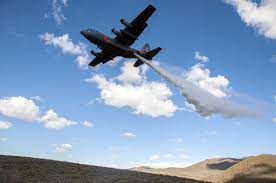In the annals of firefighting history, the evolution of aerial firefighting has been a tale of innovation, perseverance, and unwavering dedication to preserving life and property in the face of raging infernos. At the forefront of this battle against the flames stand air tankers, the aerial workhorses that deliver a devastating payload of fire-retardant to quench the fiery wrath below. From humble beginnings to cutting-edge technology, the journey of air tankers has been marked by milestones and challenges, culminating in the development of the Modular Airborne Fire Fighting System (MAFFS) as a versatile and effective solution in the fight against wildfires.
The origins of aerial firefighting can be traced back to the early 20th century when intrepid aviators first took to the skies to combat wildfires from above. In the 1920s, daring pilots began experimenting with retrofitting surplus military aircraft with rudimentary firefighting equipment, such as buckets and water tanks, to drop water or chemicals onto burning forests. These pioneering efforts laid the foundation for the development of dedicated aerial firefighting aircraft in the decades that followed.
The true breakthrough in aerial firefighting came with the introduction of air tankers, specialized aircraft equipped with large tanks capable of carrying thousands of gallons of fire-retardant or water. The first generation of air tankers, known as “borate bombers,” made their debut in the 1950s, employing a mixture of water and borate chemicals to smother wildfires and impede their progress. These early air tankers revolutionized firefighting tactics, enabling rapid response and precise targeting of fire-suppressant agents from the air.
Over the years, air tanker technology continued to evolve, with advancements in aircraft design, tank systems, and fire-retardant delivery mechanisms enhancing their effectiveness and efficiency in combating wildfires. Modern air tankers range from converted military aircraft to purpose-built firefighting platforms, equipped with state-of-the-art avionics, navigation systems, and aerial delivery systems to ensure maximum precision and safety during firefighting operations.
Among the various aerial firefighting systems developed, the Modular Airborne Fire Fighting System (MAFFS) has emerged as a versatile and invaluable asset in the firefighting arsenal. Developed in the 1970s by the United States Forest Service (USFS) in collaboration with the military, MAFFS represents a unique partnership between civilian and military agencies to enhance firefighting capabilities during times of crisis.
At its core, MAFFS is a self-contained aerial firefighting system designed to be rapidly deployed aboard military transport aircraft, such as the C-130 Hercules, converting them into temporary air tankers capable of delivering large volumes of fire-retardant or water onto wildfires. The modular nature of the system allows for quick installation and removal, enabling military aircraft to transition seamlessly between their primary roles and firefighting missions as needed.

One of the key advantages of MAFFS is its flexibility and scalability, allowing for rapid mobilization and deployment of firefighting resources in response to evolving wildfire threats. During peak fire seasons or major wildfire incidents, MAFFS-equipped military aircraft can be activated and deployed to reinforce civilian firefighting efforts, providing critical support in suppressing wildfires and protecting vulnerable communities and natural resources.
Moreover, MAFFS offers significant cost savings and logistical benefits compared to traditional air tanker operations. By utilizing existing military aircraft and infrastructure, MAFFS eliminates the need for dedicated firefighting aircraft fleets, reducing acquisition and operational costs for firefighting agencies. Additionally, the ability to integrate MAFFS onto military transport aircraft enhances operational flexibility and extends the reach of aerial firefighting capabilities to remote or inaccessible areas.
In times of crisis, such as widespread wildfire outbreaks or natural disasters, MAFFS plays a vital role in augmenting civilian firefighting resources and bolstering overall response efforts. The interoperability between civilian and military agencies facilitated by MAFFS enables seamless coordination and cooperation in the face of adversity, underscoring the importance of collaborative approaches to disaster response and mitigation.
Despite its effectiveness and versatility, MAFFS is not without its challenges and limitations. The reliance on military aircraft availability and operational constraints can impact the timely deployment of MAFFS resources during peak fire seasons or concurrent military operations. Additionally, the limited capacity of MAFFS-equipped aircraft compared to dedicated air tankers may pose challenges in addressing large-scale wildfires or prolonged firefighting campaigns.
Nevertheless, the enduring legacy of MAFFS as a best solution in aerial firefighting reflects the spirit of innovation and collaboration that defines the firefighting community’s commitment to protecting lives, livelihoods, and landscapes. As wildfires continue to pose significant threats to communities and ecosystems around the world, the evolution of aerial firefighting, exemplified by systems like MAFFS, remains essential in safeguarding our shared future against the ravages of fire.

